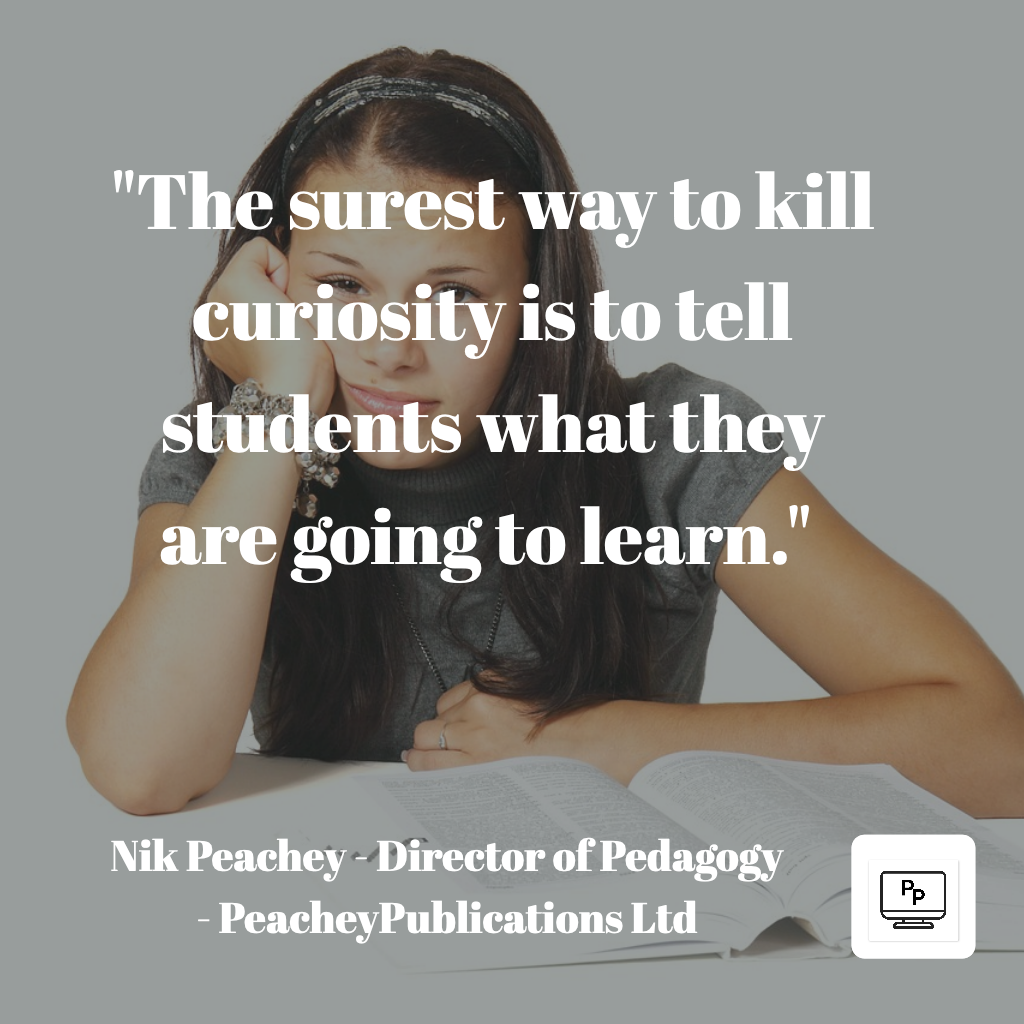I’ve been thinking about writing this post since I shared the quote below through my social network channels. I was surprised that it stirred up so much strong feeling and controversy, both against and in support of the comment. At the time I wasn’t really able to respond, but now I have a brief pause and would like to share some of my thinking about it.

I’ve always disliked telling students what they are going to learn, and have often had to resist quite considerable pressure to do this.
My reluctance to tell students what they are going to learn comes from a number things.
By telling them what they are going to learn I feel that I:
- Limit them to my own conception of what the learning goal/focus is
- Undermine their natural curiosity and their ability to work stuff out for themselves
- Reduce the need for a deeper level of cognitive engagement with material/topic
- Limit my ability to respond to what I perceive to be their needs rather than the syllabus or learning goal
- Don’t really know what they are going to learn. If you ask them at the end of the lesson rather than telling them at the beginning of the lesson, you often get a wide response of different answers (and I’m okay with that).
I know a lot of people responded with some good arguments to support telling students what they are going to learn at the beginning of the lesson and checking to see that they had learnt it at the end. Most of the common ones were:
- Students are less stressed when they know what they have to learn.
- Research says that if you tell them what they are leaning at the beginning of the lesson, then they are more likely to be able to show they have learned it by the end of the lesson.
Here are my responses to these arguments:
- I think that in order to achieve any degree or depth in your learning, you need to step outside your comfort zone. You need to be in a place where you experience being confused and having to work things out. I believe that this achieves a greater level of learning and understanding than being walked through some comfortable logical steps towards your predetermined goal.
- I’m sure that if you tell students what to learn and devise a simple test at the end of the lesson to check that, then they’ll come up with the results that you want, but I don’t believe that learning at any kind of depth really happens in that way or even within the space of one lesson.
- Learning takes time, deeper thought and attention, consideration and plenty of room for errors, reflection, confusion and reconsideration. I see learning as more of an iterative circular process than a collection of stepping stones.
- Learning isn’t just about achieving measurable learning objectives. There are a lot of other intangible, very difficult to measure but very important soft skills that students also need to learn in order to be successful, for example, empathy, curiosity, problem-solving, resilience, perseverance.
Whether you agree with me or not, I thought I’d share a collection of ten alternatives to telling students what they are going to learn.
1. Narrative
Stories are a great way to get students attention and build curiosity. You can then draw language from the story or in response to the story. This way students produce the language in a much more natural and spontaneous way without ever thinking about aims. Try to make your telling of the story as authentic as possible. Try to avoid reading and just tell the story naturally.
2. Problems
Give the students a problem to solve. Get them into small groups and get them to work at the solution to the problem. They can share their solutions together, and they might well teach each other everything you want them to know before you even have to put the aims up on the board.
3. An anecdote
Tell anecdotes as a way to lead into to a lesson. The anecdote could be to highlight what students need to learn through describing what happens when you lack this knowledge, or it could be a way to draw out language or to help students identify and understand a problem before they start thinking about what they need to know to solve it.
4. Questions
Give the students some questions to think about and work on together, and see how far they can get without your help. Then you can step in and help them when and where they need you.
5. What they know
Ask students to share what they already know about the topic or learning objective. You may find that collectively, students know quite a lot, or you may find that they bring up things that you would not have included in your lesson.
6. What they want to know
Ask students what they don’t know about a topic, what they would like to know or think they need to know.
7. Give students a menu
Give students a selection of things that they could learn about and get them to choose the things that interest them most. Get them to select the order they want to learn about them and create a learning pathway together.
8. Setting a research task
Get the students to do some research around the topic you want to teach. This can be done before the class or in the first part of the class. Be sure to get students to share and then summarise their findings. Help them to fill in any gaps in their knowledge and develop and build on what they already know.
9. A film or video clip
Use film or video clips and build tasks around them to extract the learning goal that you would like to achieve.
10. A test
Give the students a short test or quiz to find out what they know about the point you want them to learn about. This gives you much more information about where you need to start from and helps to avoid focussing on things they already know. It also helps to make the students aware of what the gaps are in their own knowledge.
The last point I’d like to make is that there seems to be a strong element of pedantry that has built up around the insistence on stating learning goals at the beginning of the lesson, and this I find very worrying. When people start to decide that something is ‘best practice’ that all teachers must conform to, then I think our system of education is heading for a very worrying place.
